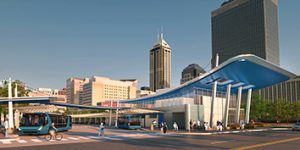
City to dub downtown transit center after Carson
Former U.S. Rep. Julia Carson was instrumental in securing funding for an Indianapolis public transportation hub.

Former U.S. Rep. Julia Carson was instrumental in securing funding for an Indianapolis public transportation hub.
The debate over whether Indianapolis residents should be able to vote this November on an income tax increase to pay for improved public transportation will soon heat up.
The first phase of the $198 million Red Line is slated to run from just north of Broad Ripple to the University of Indianapolis.
IndyGo has received the last of 21 fully electric buses. Those buses, equipped with lithium-ion batteries, can travel up to 130 miles on a single charge.
Officials say the first phase of a rapid transit line that should eventually connect Westfield to Greenwood won’t be delayed even though the Indianapolis region missed out on a share of $84 million in state funding from the Regional Cities Initiative.

Congress has dedicated the money to Indiana roads and bridges as part of a 5-year, $281 billion compromise over transportation spending. The measure also includes $500 million for public transit in Indiana.
The City-County Council voted Monday for Indianapolis to join Carmel, Westfield and Greenwood in an economic development group seeking state funding for a rapid-transit route.
Hamilton County leaders are getting a clearer picture of what a public transit bus system could look like and, according to a new study, the annual operating cost could range from $10 million to nearly $25 million.

The team charged with designing and engineering downtown’s $20 million transit center—which has begun to emerge south of Washington Street between Delaware and Alabama streets—took on three core challenges.
Fishers has paid out about $35,000 since agreeing to subsidize the commuter route to downtown Indianapolis last year.

The city bus company is in the midst of a technology upgrade that’s supposed to include next-bus arrival information via digital signs at downtown stops and text messaging.
Carmel Mayor Jim Brainard on plans to discontinue commuter-bus service to downtown Indianapolis: Disappointed, but city “would support future efforts to bring a strong public transportation system to the Indianapolis area.”
The Hoosier State line that runs from Indianapolis to Chicago saw a 10-percent decline in revenue and a nearly 8-percent drop in ridership for its fiscal year.

IndyGo isn’t threatening to eliminate routes, but it is trying to craft a policy to guide it through landmark changes: next year’s opening of the $20 million Downtown Transit Center and, possibly, the passage of a referendum in favor of a regional rapid-transit system.
Two reverse-commute routes will serve the north Plainfield and Whitestown warehouse districts, taking workers from Indianapolis to major employers like Amazon, GNC, Ingram Micro and Tempur Sealy.
A little-used, delay-plagued passenger rail line from Indianapolis to Chicago has become a battleground, as Amtrak tries to fend off competition invited by the Indiana Department of Transportation.
The mayors of Indianapolis, Carmel, Westfield and Greenwood on Tuesday announced a potential plan and a timetable for The Red Line, a proposed rapid-transit all-electric bus route that would stretch 28 miles from Hamilton County to Johnson County.
Carmel City Council voted 7-0 Monday to subsidize the Indy Express commuter bus for the rest of this year, but members made it clear their support was tenuous at best.
Indianapolis experienced one of the fastest gains in car-less households of any major city in a recent five-year period, according to U.S. Census data compiled by a University of Michigan researcher.
An Indianapolis software startup that hopes to win contracts from public-transit agencies across the country is protesting a no-bid deal by IndyGo.